Siquijor Itinerary: 4 Days on the Island of Witches
Are you planning a trip to the Philippines?
Wondering what to do on the island of Siquijor?
In this post, I’ll share with you EXACTLY how to spend your time in Siquijor. This 4-day Siquijor itinerary allows you to experience the island’s most popular waterfalls and beaches (including a secret beach), visit a shaman, and swim with turtles.
I recommend spending 4 days in Siquijor. It’s enough time to relax on the beach, see the most popular spots, and also explore some off-the-beaten-path places. This post also includes valuable info on how to get to Siquijor and how to get off the island to continue your Philippines travels.
Check out my Philippines itinerary that focuses on Cebu and surrounding islands. If you’re looking for where else to travel to in this beautiful country, check out my 15 favorite places to visit in the Philippines.
You can also find ALL of my Philippine posts on my Philippine travel guide page.
Disclosure: This post may contain affiliate links. As an Amazon Associate and a Bookshop.org Associate, I earn from qualifying purchases. Please see this website's Disclosure for more info.
In This Siquijor Itinerary, You’ll Find…
- About Siquijor – The Island of Witches
- Siquijor Itinerary Day 1 – Arrival + Tubud Beach
- Siquijor Itinerary Day 2 – Island Tour (Waterfalls & Beaches)
- Siquijor Itinerary Day 3 – Apo Island
- Siquijor Itinerary Day 4 – Countryside Tour + Departure
- Siquijor Travel Guide & FAQs
About Siquijor: The Island of Witches
Siquijor (pronounced Seekeehor). The Spanish called it Isla del Fuego, the Island of Fire. There were so many fireflies on the island that at night it appeared as if the island was on fire. Unfortunately, I didn’t see any during my time on the island.
However, Siquijor has another more mysterious name: The Island of Witches.
During colonial times, the Visayas (the area where Siquijor is located) was a popular trading area for the Spaniards. When sailors got sick, they’d stop off in Siquijor to get treated. But once they figured out how they were actually being treated (shamans and sorcerers), they gave the island the name “Island of Witches.” Even now, the island has become known for its witchcraft and sorcery.
Siquijor doesn’t have any witches like you’d find in a Grimm’s Fairy Tale. At least I don’t think it does.
It does have shamans or faith healers. These are people who use herbs, faith, and other unorthodox methods like water and stone or blowing down the back of your shirt to cure people’s ills, ward off evil spirits, or make others fall in love with you.
My guide says that locals, including himself, really do go to these healers when they are sick or when they need some luck.
Can foreign travelers to Siquijor visit a shaman?
I did! I’ll tell you later in this Siqujior itinerary how you can visit one and whether it’s worth it.
You’ll find the small island of Siquijor stuck between Bohol, Cebu, and Negros. You can reach it from either of those islands, which you can read about in the section below on How to Get to Siquijor and in my Bohol Itinerary post.
When I first saw Siquijor on a map, it looked small compared to its neighbors. So I expected it to be easy to get around on foot.
Hah!
Boy, was I wrong!
When you get there, you realize it’s a lot bigger than it looks. It can take you 3-4 hours by motorbike to make it around the whole island. Your butt can get really sore sitting on a motorcycle during those 3-4 hours! And getting from Larena port to the main tourist area can take 45 minutes.
Several small towns dot the coast of Siquijor. The main ports are in the towns of Larena and Siqujior. Most people arrive at the port of Larena. The Siqujior port is used more for tour boats.
Here are some of the main towns:
- Larena: the main port for boats to Bohol and Lilo-An; Sandugan Beach, and some resorts
- Siquijor: the main port for boats to Dumaguete; some good resorts and beaches
- San Juan: Tubod Beach and Marine Sanctuary; lots of hotels here
- San Antonio: located in the interior/ it’s where you can find shamans
- Lazi: famous for its Spanish colonial church and Cambaguhay Falls
- Maria: the closest town to the cliff diving on Salagdoong Beach; check out Kagusan Beach
PRO TIP: No one likes to think about insurance, but accidents do happen. I highly recommend getting travel insurance. During my travels over the past 2 years, I've been using SafetyWing for my insurance. They're very affordable for all ages, and digital nomads can use their insurance long-term.
Siquijor Itinerary Day 1
The following itinerary for day 1 in Siqujior is EXACTLY how I spent my time on the island. You don’t have to follow my itinerary exactly. Just use it to give you some ideas on how you can organize your time on the island.
- Getting from Bohol to Siquijor by ferry
- Getting to your hotel and checking in
- Tubud Beach and Marine Sanctuary
- Dinner
Stop #1: Getting to Siquijor by Ferry
I got to Siquijor from Bohol by ferry, leaving at 10:00 am and arriving at noon at Larena Pier. My hostel picked me and other guests up in the back of a pickup truck. It was an hour drive from the port to the hostel near Tubud Beach.
You can find ferry schedules and book tickets on 12Go
Here are all the different ways in getting to Siquijor. Some are easier than others.
- Ferry from Bohol to Siquijor
- Ferry from Cebu to Siquijor
- Ferry from Dumaguete to Siquijor
- Ferry from Liloan to Siquijor
Ferry: Bohol – Siquijor
Ferries leave from and arrive in Bohol from the port in Tagbilaran. For info on traveling around Bohol, check out my Bohol Travel Guide.
Ferries to and from Bohol arrive at and depart from Larena Pier in Siquijor or the Siquijor Pier.
First, try buying from the 12Go website. If they’re sold out on the website, try to buy them at the Tagbilaran Pier in Bohol.
Departure Times from Bohol:
- 8:00 pm – 11:00 pm (Larena Pier) – US$12
- 3:20 pm – 5:20 pm (Siquijor Pier) – US$16
- 10:00 am – 12:30 pm (Larena Pier) – US$13
I took the 10:00 am ferry.
Ferry: Cebu – Siquijor
There’s now a direct ferry from Cebu City to Siquijor. Ferries usually leave from Pier 1 in Cebu.
First, try buying them from the 12Go website. If they are all sold out, check at the pier in Cebu.
- 1:00 pm – 6:20 pm – US$35 (Arrives at Siquijor Pier)
- 1:00 pm – 11:00 pm – US$15 (Arrives at Larena Pier)
And if you’re coming from Manila, you’ll still need to fly into Cebu. For info on traveling in the capital, read my Manila itinerary post and my Tips for First-Timers in Manila.
Ferry: Liloan – Siquijor
If you’re trying to get from Moalboal or Oslob to Siquijor, you’ll want to leave from the Pier in Liloan on Cebu Island. The ferry company that plies this route is Maamyo Lines.
First, take a bus from Moalboal Town to Batu and then a tuk-tuk to Liloan.
The problem is that there’s only one ferry on Mondays, Tuesdays, Thursdays, Fridays, and Saturdays, and it leaves at 2:00 am and arrives at 4:00 am. There’s a 7:00 am ferry that leaves on Sundays.
You can’t buy tickets online. Expect to pay around US$5.
Read more about how to get to Siquijor from Liloan here.
Ferry: Dumaguete – Siquijor
Dumaguete is another departure point for those coming from Moalboal.
You’ll need to first take a bus from Moalboal town to Bato and then a tuk-tuk to Liloan Pier. But you’re not done. Next, take a ferry to Sibulan Port. Finally, a tuk-tuk to the Dumaguete Pier.
First, try buying your ticket online from 12Go website. If it’s sold out, go directly to the Pier.
Ocean Jet Ferry
- 7:20 am – 8:20 am (Siquijor Pier) US$8
- 7:10 pm – 8:10 pm (Siquijor Pier) – US$8
Montenegro Shipping Line
- 7:00 am – 8:30 am – US$2.30
- 10:00 am – 11:30 am – US$2.30
- 12:00 (noon) – 1:30 pm – US$2.30
Aleson Shipping Line
- 5:30 am – 7:00 am – US$2.70
- 10:30 am – noon – US$2.70
- 2:00 pm – 3:30 pm – US$2.70
Check this website for further information on more ferries from Dumaguete to Siquijor.
PRO TIP: ALWAYS contact your hotel or hostel before arriving to find out the best way to get from the bus station/train station/ferry port to the hotel/hostel. They usually know the ins and outs of the public transportation system and they know the most current and best way to get somewhere compared to a guide book, another traveler on a forum, or a blog post. Sometimes newer places or more corporate places don’t know (like Crazy Bears Hostel in Moalboal gave me the wrong information).
Stop #2: Check into Your Hotel
The next step on this Siquijor itinerary is to get to your hotel and check-in. Larena Port is quite far from where most people stay on the island. Siquijor also has no public transportation except for tuk-tuks and motorcycles, so it’ll be hard to get from the port to your hotel.
I recommend messaging your hotel or hostel before arrival to arrange for a pickup at the port. That’s what I did. It cost me US$5.
I stayed at TAGBALAYON Lodging House, right across from Tubud Beach and Marine Sanctuary (you can snorkel off the beach). Luckily, this place survived the Pandemic. It’s still highly rated on Booking.com at 9.4/10 and on Agoda it’s also a 9.4. The hotel has dorm rooms and private rooms. The dorm was clean, the staff was friendly, the location was superb, and they offered an inexpensive breakfast. I loved how the staff greeted every guest by name every day. My only complaint was the showers flooded and the dorms had too many beds.
If dorms and budget hotels aren’t your thing, Siquijor has lots of other wonderful hotels. For a medium-priced hotel try Isla de Paz Beach Resort. It’s right on the beach, gets great reviews, and is at an affordable price. Check reviews and prices on Booking.com or Agoda.
Across the road from my hostel was The Coco Grove Beach Resort. This gorgeous hotel is right on the beach! There’s also a swimming pool. I booked my Apo Island tour through them, so I got to experience a bit of its luxury service. Check reviews and prices on Booking.com or Agoda.
Stop #3 Tubod Beach and Marine Sanctuary
After checking into my hostel and having lunch at the hostel, my first stop was Tubod Beach and Marine Sanctuary, which was across the street from my hostel and in front of the swanky Coco Grove Beach and Dive Resort.
The best part of Tubod Beach is that a Marine Sanctuary is in front of the beach.
I had to pay 50 pesos (US$1) to swim in the Marine Sanctuary and 100 pesos (US$2) to rent masks and snorkel. I paid the entrance fee at a little hut right before entering the beach area.
You can also rent gear from the Coco Grove Dive Center, toward the back of the beach. Rumor has it that their equipment is better than the stuff at the Marine Sanctuary.
The water in front of the beach was as calm as a pond. There wasn’t a wave or even a ripple on the surface.
There is a lot of coral close to the shore, so you can easily swim out to it or even walk out to it and swim around. The coral is pretty healthy, so you should be able to see lots of colorful coral fish.
Unfortunately, you need to be careful of jellyfish.
PRO TIP: Make sure to buy water shoes for your trip to the Philippines. The bottom of the ocean is rocky and it’s easy to cut yourself or break your toe or foot while walking in the shallow part of the ocean.
Stop #4 Dinner at a Pop-Up Restaurant
I hadn’t been very lucky at finding good food in the Philippines up to that point, but dinner on day 1 of this Siquijor itinerary was fantastic. There is an outdoor pop-up restaurant along the ocean. It’s kitty-corner to Casa Miranda Hostel (just tell the tricycle driver that you want to go to Casa Miranda Hostel) on the road that runs around the island.
The people who ran the place set up a food cart with trays of food and a barbecue grill on Lalao Bridge (or near it). The food in the trays had already been cooked, but they grilled chicken and fish in front of you. You pointed to what you wanted and servers put the food on individual plates and then brought them to your table. They recorded what you ordered in a notebook and added up the bill at the end of the evening.
The food was fantastic and reasonably priced. They had potato salad, green beans, grilled fish, grilled chicken, fried bananas, mango cake, spring rolls, noodles, and choco balls covered in bits of coconut. Most of the dishes were vegetarian.
This is a place you want to go to with other people.
A bonus was that you could watch a stunning sunset over the ocean while you waited for and ate dinner.
The restaurant disappeared at the end of the evening until the next evening. I didn’t see it on my third evening on the island, though.
I don’t know what the name of the place is, but you can’t miss it. You’ll see a long line of foreign tourists along with a few locals. It’s not far from the Aloha Restaurant.
How to Get Around Siquijor
Like most tourist places in the Philippines, there are no public buses. On Siquijor, you mainly have to rely on tricycles (tuk-tuks) and motorcycles or scooters. Tricycles are expensive. Expect to pay at least 150 pesos (US$3) for a 5- or 10-minute ride somewhere.
You can rent a motorcycle or scooter from your accommodations or at the port for 300 pesos (US$6) a day.
But if you don’t know how to ride a motorcycle or scooter, you can hire a guide and driver to take you around. That’s what I did. I paid 300 pesos (US$6) for the motorcycle plus gas and 500 pesos (US$10) for the guide per day. He drove the motorcycle and I just sat on the back of it. I got to go to places that I would not have found on my own.
Getting from the port to your hotel can be costly. I’ve been told that there are jeepneys that do the route, but I didn’t see any. I arranged a pickup through my hostel. It cost me 250 pesos (US$5) for the pickup. I can’t remember the price for a tricycle, but I know it was at least 500 pesos (US$10).
Siquijor Itinerary Day 2: Island Tour
You shouldn’t skip day 2’s itinerary. Compared to everything else on the island, this is the best part of the Siquijor itinerary.
The key to having a great island tour is to start REALLY early because some of these sights are pretty popular and they can get quite busy. But even if you can’t leave early, don’t fret. You’ll still have a fantastic time. I started my itinerary at 9:00 am, but I would have liked to have started at 8:00 am.
- Balete Tree
- Lagaan Falls
- Lazi Church and Convent
- Cambugahay Falls
- Monkey Beach (Secret Beach)
- Lunch
- Cliff Jumping at Salagdoong Beach
- Paliton Beach
How to Do This Tour?
To do this Siquijor Island tour, you’ll need some wheels. There’s no public bus system on Siquijor.
- Rent a Scooter or Motorcycle – The most popular way to do this Siquijor Island Tour is by renting a scooter or motorcycle.
- Hire a Motorcycle Driver – If you can’t drive a scooter or motorbike, don’t worry. You can hire a guide and rent a motorbike. He or she drives the motorbike while you sit on the back of it. This is what I did, and it worked out well because my driver took me to some places that I would have had a hard time finding on my own. My hostel arranged everything for me. It cost me 300 pesos (US$6) to rent the motorbike, 500 pesos (US$10) for the guide, and around 300 pesos (US$6) total for gas for the whole day.
- Join a Tour: If you’re coming from Dumaguete, you can join a day tour of Siquijor. You’ll see some of the same sights that I saw on day 2 of my Siquijor itinerary.
Stop #1 Balete Tree
OPEN: 6:00 am – 6:00 pm | COST: 20 pesos + 5 – 10 pesos for parking | LOCATION: Google Maps
The first stop of the day 2’s Siqujior itinerary is a 400-year-old tree called the Balete Tree.
There’s a little pool in front of the tree where you can soak your feet in and have fish nibble on your dead skin. It’s supposed to be therapeutic.
Stop #2. Lagaan Falls
COST: 50 pesos + 10 pesos for parking | LOCATION: Google Maps
The next stop on day 2 of this Siquijor itinerary is Lagaan Falls. Several waterfalls dot the island of Siquijor. When I was there in February (the height of the dry season), though, only 2 waterfalls had water. One of the better waterfalls, Lugnason Falls, was dry.
Lagaan Falls is harder to get to than the more popular, Cambugahay Falls. It’s over a bumpy unpaved road. After you park your bike, you have to walk along a path without signage. It’s a small waterfall, but it’s not crowded. When I was there, there was only one other group of tourists. There is a rope that you can use to swing and jump into the water. You can also slide down the waterfall.
Stop #3. Lazi Church and Convent
OPEN: 7:00 am – 5:00 pm | ENTRANCE FEE: 20 pesos (convent) free (church) | LOCATION: Google Maps
The third stop on day 2’s itinerary was at beautiful Lazi Church and Convent, called the San Isidro Labrador Parish Church and Convent.
Both the church and convent were built in the 1800s, and both were made out of coral. You can tour both the church and the convent.
The convent has now been turned into a museum. The museum houses some old but uninspiring artifacts. I recommend entering the convent, taking a photo of the staircase inside the entrance, and then leaving. Skip the rest of the museum.
Stop #4. Cambugahay Falls
OPEN: 8:00 am – 5:00 pm | ENTRANCE FEE: 50 pesos + 10 pesos for parking | LOCATION: Google Maps
The highlight of this Siquijor itinerary is Cambugahay Falls. It’s a beautiful waterfall and a lot of fun to spend an hour or two hours swimming, swinging from a rope, or just relaxing. The other great thing is that you can easily get to the falls by tricycle.
This is a multi-tiered waterfall. Each tier has pools that you can swim in. One pool has a rope that if you’re patient enough to wait in line, you can swing from.
There are also these smaller pools that are like sitting in your own natural jacuzzi.
Stop #5 Monkey Beach (Secret Beach)
ENTRANCE FEE: free | LOCATION: Google Maps
The last stop before lunch was at Monkey Beach. This is the beach that backpackers talk about as the mysterious “Secret Beach,” where locals go. If you’re on your own, it might be hard to get to. BUT it’s not impossible to find as Monkey Beach is on Google Maps and there are signs pointing the way after you make the correct turnoff from the main road.
After you follow the directions on Google Maps, you’ll come to a forest on your left and a restaurant on your right. There is a sign and a stuffed monkey nailed to a tree pointing in the direction of Monkey Beach. You can drive your scooter through the forest until the road becomes impassable. You can also park it next to the sign with the monkey. Keep on walking until you come to a cliff. Go down the rickety old stairs to the beach.
You are now at Monkey Beach / Secret Beach. To be honest, I wasn’t that impressed. It’s a quiet beach. Just two other groups of travelers were there. What I didn’t like was that the waves were pretty rough and the ground was very rocky so swimming wasn’t much fun here. The beach was also strewn with lots of seaweed and other debris from the ocean.
If you don’t ever make it here, don’t sweat it. It’s not THAT great.
Stop #6. Lunch
By now, we were pretty hungry so my guide took me to Chef Joe’s Cuisine in Maria.
My guide promised to take me somewhere local and inexpensive. I’m pretty sure Chef Joe’s Cuisine was NOT where locals usually go because the only people at the place were foreign tourists. The prices were typical foreign tourist prices, but it wasn’t overly expensive. The menu was a mix of Chinese and Western dishes, and overall it was decent.
By the way, they have WiFi. Just ask the staff for the password.
I paid for my driver’s/guide’s lunch.
Stop #7. Cliff Jumping at Salagdoong Beach
OPEN: 8:00 am – 5:00 pm | ENTRANCE FEE: 50 pesos + 20 pesos for parking | LOCATION: Google Maps
Guidebooks and some travelers rave about Salagdoong Beach. But I found it be the worst beach on Siquijor. It’s overdeveloped and small, and you have to pay to enter.
The main reason for going to Salagdoong Beach is to do cliff jumping. You climb up this rock or tiny hill where you’ll find two platforms for diving. One platform is at a lower height than the other. This lower one is sometimes closed when the tide is out.
I didn’t want to jump but my guide chose to do it twice! When you’re standing up at the top of the rock and looking down, it looks pretty far and scary. But when you’re standing on the beach and looking up at the rock, it looks pretty tame.
It’s a small and rocky beach. If you’re not into cliff jumping, you can easily scratch Salangdoong Beach from your Siquijor itinerary.
Stop #8 Paliton Beach
ENTRANCE FEE: free | LOCATION: Google Maps
Luckily, day 2 ended with the most beautiful beach on Siquijor – Paliton Beach. It’s also quite popular.
Like Tubod Beach near Coco Grove Beach Resort, the water at Palliton Beach is as calm as the surface of a glass of water. Not a ripple or wave. The beach is long and wide. You’ll also find places to eat and drink.
It’s a great beach for watching the sunset.
I would have liked an extra day during my stay in Siquijor just to hang out on this beach during the daytime. I was there pretty late in the afternoon.
Siquijor Itinerary Day 3: Apo Island
One of the top 3 things I did in Siquijor was to visit Apo Island and snorkel with the sea turtles. Don’t skip this part of your Siquijor itinerary.
A couple of places offer island hopping trips to Apo Island to snorkel with the turtles. Coco Grove Beach and Dive Resort offered turtle tours of Apo Island for 1,950 pesos (US$35). Another place that offered tours was Ocean Life Explorers for 1,750 pesos (US$31). Prices in 2024 are higher than when I went. You’ll most likely pay over 2,100 – 2,750 pesos (US$37 – $49). It’s still a good deal considering other places in the world.
I tried to book a tour with both places. At first, when I tried to book with Coco Grove on day 1, they were full, so I put my name on a waitlist. On day 2 of my Siquijor itinerary, I tried to book with Ocean Life Explorers, but they were also fully booked. Luckily, a seat opened up with Coco Grove the night before.
Stop #1 Departure for Apo Island
My tour started at 7:30 am from the lobby of the Coco Grove Beach and Dive Resort where we met our guides and got into a van to go to the Siquijor Pier.
The above picture on the left is the luxury boat that we took to Apo Island. The boat on the right is a typical island-hopping boat in the Philippines. This was the fanciest boat I’d been on in the Philippines. The interior was just as nice.
There must have been over 30 people on this tour from as young as under one year old. I was the only solo traveler. And probably the only one who slept in a dorm room the night before!
It took an hour (8:30 – 9:30) for our boat to get to Apo Island. Apo Island is a tiny volcanic island (716 inhabitants) with an area of 74 hectares. When I first saw it from the boat, I was quite disappointed. From the Siquijor side, it looked like one massive rock. It was not until we got to the other side of the island that I could see a beach, buildings, and a lot of boats.
In 1982, the sea around Apo Island became a marine sanctuary. Since then, no one has been allowed to fish using dynamite or cyanide or the banging of rocks to scare fish into nets. As a result of this protection, the coral around Apo Island is very healthy. There are 650 species of fish and 400 species of coral. This makes it a great place for snorkeling and diving.
Stop #2 Snorkeling in the Coral Garden
I was surprised by the snorkeling that we did. I thought the boat would anchor near some reef and then we would freely snorkel around the boat, get back on the boat, go for lunch, drive to another reef, and then snorkel some more. It wasn’t at all like that.
Instead, our beautiful yacht anchored off the coast of the island and then we swam to the island in groups of 4. Each group had their own guide, who had a life preserver.
The tour leaders took our bags to the island on a small boat.
The problem with the whole experience was that the water was rough and the current was strong and against us. As a result, we couldn’t stop and observe the turtles. We had to keep on swimming and swimming to get to shore. And it was a long way to shore. If you go to the Galapagos, you’ll also swim with lots of sea turtles but you’ll get to take your time and observe.
It was called a coral garden because there were massive mounds of coral. I’d never seen such huge coral. It wasn’t brightly colored coral like I saw on Pamilacan Island.
Most importantly, I saw lots and lots of turtles – around 10 turtles that morning. Apo Island has so many turtles because this is where the female turtles go to feed. Since it’s been a marine sanctuary for so many years, the turtles have no predators here and there’s lots of food for them to eat.
The turtles were massive. I think some of them were the size of a dining room table that could seat six – even bigger than the turtles I saw on my Galapagos cruise.
There are two kinds of turtles on Apo Island: green turtles (actually brown colored) and hawksbill turtles. The Hawksbill turtles have these pointy beaks and shells that look like puzzles.
They would swim right next to us or right under us, completely unafraid of us humans. They’re not scared of humans because as a protected area, there are no human predators here, just a lot of annoying but innocuous tourists.
Stop #3 Lunch
We swam to the shore and rested on the beach. Unfortunately, it was difficult and painful to walk on the beach as it was full of broken coral. Luckily, I had sea shoes on. You can also have your guide tie your flip-flops to the life preserver.
The Resort gave out beautiful fluffy towels to everyone that you then had to put in your dry bag so that you had it when you get back to the boat.
Now lunch was another sign that I was traveling among people who weren’t budget travelers. The meat and vegetables were good quality. I hadn’t tasted food like that since I left the United States. I think I’d been spending too much time in cheap restaurants in the Philippines. We also had fancy silverware that you would never get in all the cheap restaurants I had been frequenting.
Stop #4 Snorkeling back to the boat
In the afternoon most of us snorkeled back to the boat, while a handful of people went off diving. We saw the same kind and amount of turtles and coral in both.
I’d say we saw around ten turtles that afternoon.
Siquijor Itinerary Day 4: Countryside Tour
My final day on Siquijor was spent touring the interior part of the island. Most people do not get to see this part of the island. They focus more on the coast.
I was lucky to have found a great guide who was available to take me to see a more off-the-beaten-path part of Siqujior and to visit a Shaman.
The tour of the countryside took from 9:00 am to 12:00 pm. I spent the afternoon buying tickets and departing from Siquijor.
- Kamp Aninipot
- Secret Lagoon
- Shaman
- Cantabon Cave
- Mt. Bandilaan
- Buy Tickets for Fery to Liloan
- Depart Siquijor
Stop #1 Kamp Aninipot
ENTRANCE FEE: 10 pesos | LOCATION: Google Maps
Our first stop on the last day of my Siquijor itinerary was Kamp Aninipot (Camp Fireflies).
Kamp Aninipot is a campground with a restaurant and accommodations overlooking Siquijor and the ocean. The views are gorgeous. I’m sure the sunsets are as well.
The campground has (also called Hobbit Huts), small huts that look like they come from Lord of the Rings. There’s also an Airbnb that’s a treehouse.
Stop #2 Secret Lagoon
The best thing I can say about Secret Lagoon was that we passed some scenic rice paddies on the way up to the place.
The Secret Lagoon is just a pond. It’s pretty but nothing out of this world.
Stop #3 Shaman
The part of this itinerary that I was most looking forward to turned out to be one of the strangest things I did in the Philippines.
Arriving at the shaman’s residence, we were greeted with two signs in English. On the one hand, seeing the name of the famous Ponce family, I felt assured that I was getting a legitimate shaman. On the other hand, was the sign in English an indication that this was a tourist trap? But then again almost all signs in the Philippines are in English.
Two young children, a boy and a girl, were home. But no shaman. She (not a he) was out grocery shopping. Why weren’t the children in school? I had noticed this many times in the Philippines. Young children out on the street or in their front yard during school hours.
The house was a wooden shack strewn with garbage and empty beer bottles. We took off our shoes even though the floor looked like no one had ever cleaned it.
We decided to wait amongst the empty beer bottles and trash. And then my guide saw a dilapidated karaoke machine from the 1980s and got the bright idea to sing karaoke right there at the home of this shaman. My guide sang a love song about forbidden love in Tagalog or the local Cebuano (there were English subtitles).
Was he singing it to me?
Unfortunately, the karaoke machine wasn’t in the best condition, so it was screeching and scratching. The whole experience that should have taken place in a karaoke bar was so out-of-place in this idyllic countryside setting.
Before my guide could finish his song (thank God!), the shaman returned from shopping. She was a short, unsmiling middle-aged woman.
The shaman had me sit in the middle of a dark room, whose walls hung pictures of Jesus and Santa Claus.
She felt my pulse for five seconds, massaged my shoulders neck and arms, and blew down the back of my shirt. The whole treatment or exam lasted more or less ten minutes.
After finishing, the first words out of her mouth were a disappointing sales pitch, “You want a potion to ward off evil and bad things?”
“How much?”
“1,000 pesos.”
(That’s US$20.)
“No, thank you. So, what’s wrong with me? What are my ailments? Did you find anything wrong?”
Her assessment of one of my chronic ailments was surprisingly spot-on. But she didn’t offer any medicine for it.
She also said I hadn’t had a massage in a while. Very true.
Shamans can’t charge for their services directly. Instead, you give a donation. My guide was of little help.
“Give whatever you think.”
I’m bad at assessing prices. I usually give too much or too little. Using Lonely Planet as my guide, I gave 200 pesos (US$4). I’m not even sure she was worth that much. I think you can get an hour-long massage for 300 to 500 pesos.
You can buy other kinds of potions. The potions are herbs that are encased in stone and then hung around your neck (see photo above).
The potion to ward of evil comes in two sizes. The small one is 500 pesos (US$10) and the big one is 1,000 pesos (US$20). There’s also a love potion to get others to fall in love with you. Maybe I need that one I thought. But it’s 1,000 pesos as well.
We thanked the sorceress for her time and then got back on our motorcycle. So that was a shaman. It all seemed more like a scam to get money out of tourists than something real. I had a hard time accepting that this was someone that locals really went to. Maybe I got the foreign tourist treatment, while locals get something more authentic.
Read More Articles on the Philippines:
Stop #4 Cantabon Caves
ENTRANCE FEE: 20 pesos + 500 pesos for a guide + equipment fee | LOCATION: Google Maps
The next stop on my last day in Siquijor was a visit to the Cantabon Caves. I’m not a big cave person. There are bats in caves and bats have been known to be the origins of many of today’s deadliest diseases like Ebola and not to mention COVID-19. However, reviews of the caves on Trip Advisor were very positive, so I decided to go.
Unfortunately, the reviews and my guide didn’t mention that the water in the cave goes up to your waste. I hadn’t dressed for that much water. So, we didn’t go into the cave.
If you do want to explore Cantabon Cave, first go to the ticket office to pay the fee and get your guide and gear (helmet and lights) before proceeding to the cave, which is several meters away. You need to hire a guide for 500 pesos and pay the entrance fee of 20 pesos. It costs 30 pesos to rent a light, 50 pesos for shoes, and 50 pesos for a ziplocklock.
Stop #5 Mt Bandilaan
ENTRANCE FEE: Free | LOCATION: Google Maps
The highest point on Siquijor is Mt. Bandilaan, at 632 meters above sea level. You can see 360-degree panoramic views of the island.
There are two ways to get up to the top.
- A stairway built into the side of the mountain
- A pathway that is lined with stations of the cross.
We took the stairs.
At the top of the hill is a viewing tower. It’s ok. I wouldn’t go out of my way to see this place.
Stop #6 Buying Tickets to Lilo-An and Lunch
I ended my trip to Siquijor by purchasing ferry tickets to Liloan, where I would get a bus (turned out to be a taxi) to Moalboal.
I had lunch at the highly recommended Aloha Restaurant. It wasn’t very good. I think it was the worst food I’d eaten in the Philippines. The only good thing about this place was the stunning view from the restaurant.
Stop #7 Departing from Siquijor
I took the ferry from Siquijor to Liloan at 5:00 pm. We got to Liloan at 8:00 pm. Several people in Liloan told me that the last bus to Moalboal had left at 7:00 pm. I’m not sure if this was true. However, it was late, so I decided not to try my luck at the bus station and instead, looked for a taxi.
Luckily, I found a couple from Germany, and we hired a taxi for 1,200 pesos (US$24).
Looking for more off-the-beaten-path destinations?
Siquijor Travel Guide & FAQs
- Where to stay in Siquijor?
- When to visit Siquijor?
- What’s Siquijor like for Solo Travelers?
- What to pack for Siquijor?
Where to Stay on Siquijor?
Most travelers stay on the southwest coast of the island in San Juan. This area of the island has the nicest beaches–the water is smooth and calm, really great for swimming and snorkeling. The sunsets are amazing!
I stayed at Tagbalayon Lodging House (Booking.com | Agoda) a hostel directly across from Tubod Beach and Coco Grove Beach and Dive Resort in San Juan. Perfect location!
The people who own the place were wonderful. I liked how the people who worked there always greeted me by saying my name despite that there were so many other people saying there.
The dorm rooms are kind of tightly packed and the showers flooded, though. I often found myself walking over everyone else’s backpack to get anywhere in the room.
There’s a nice common area on the second floor with comfy couches and lounge chairs. The hostel has a decent restaurant with an inexpensive buffet and more expensive dishes from a menu. There’s also a little grocery store for you to buy snacks and drinks.
Another great budget option is Fable Hostel (Booking.com | Agoda). It gets terrific reviews (9.7/10), and it’s near the best beach in Siquijor, Paliton Beach!
For those who want a budget hotel but don’t want a hostel, check out Chekesh Casa (Booking.com | Agoda). It gets great reviews and is near Tubud Beach.
For a medium-priced hotel try Isla de Paz Beach Resort. It’s right on the beach, gets great reviews, and is at an affordable price. Check reviews and prices on Booking.com or Agoda.
The Coco Grove Beach Resort is right on the beach! There’s also a swimming pool. Check reviews and prices on Booking.com or Agoda.
When to Visit Siquijor?
From January to May, the island is at its driest. This can be both good and bad. The good is obvious, but the bad is that some waterfalls are empty. Siquijor gets more rain from June to November.
It is coolest from December to March with temperatures averaging 28 degrees Celsius (83 degrees Fahrenheit). The hottest time is from April to November with the average temperature being 33 degrees Celsius (91 degrees Fahrenheit).
Siquijor seems to be more popular with Europeans than local Filipinos. Keep in mind that Europeans like to travel from December to March when their own countries are at their coldest. So, during these times. you’ll find a lot of the more popular places booked.
What’s Siquijor Like for Solo Travelers
Siquijor is a good place for solo travelers.
As a female traveling solo, I felt quite safe.
If you’re on your own and you don’t drive a motorcycle, you can hire a guide/ motorcycle driver for 500 pesos (US$10) a day plus for the motorcycle 300 pesos (US$6).
You can get more tips and insider info on what it’s like to travel alone in this beautiful country in my Solo Travel Guide to the Philippines.
Final Thoughts on this Siquijor Itinerary
There you have it! I hope this travel guide helps you in planning your trip to Siquijor.
So, did Siquijor live up to my expectations? Hiring a guide and driver was the best decision I made. I got to go to places like Monkey Beach and experience seeing a shaman which I wouldn’t have done on my own. And US$10 a day for a guide is a pretty good deal. You’d spend twice that at a restaurant in the United States.
I would have liked to have stayed a day longer on Siquijor, visiting a few more beaches.
Since it was the dry season, some of the waterfalls were dry, so I couldn’t see them.
Siquijor is a great place to add to your Philippines itinerary! It’s a great place to visit after a trip to Bohol.
Is it touristy? It’s less touristy than some of the other places I’ve been to in the Philippines.
By the way, if you’re looking for more info on the Philippines, check out my Philippines Travel Guide page.
Best Resources for Planning Your Trip to the Philippines
Book Your Flight to the Philippines
Use Skyscanner to find the cheapest flights to the Philippines. They will turn up results for all airlines including major ones and local airlines. You’re going to find EVERYTHING that’s available and thus get the cheapest price.
Book Your Accommodations for the Philippines:
The best hotel booking sites for the Philippines are Agoda and Booking.com. Both sites have the biggest selection, and they consistently churn out hotels and hostels at the lowest prices of any other booking site. Another website for backpackers and budget travelers is Hostel World.
Book Your Tours for the Philippines:
The three best tour booking sites for the Philippines are Viator and Get Your Guide. Viator has the biggest selection. Get Your Guide has terrific customer service. They will help you if you have trouble with your tour, especially if the tour company cancels your tour or doesn’t show up. I also like using Klook for booking tours in Southeast Asia.
Buy Your Ferry and Shuttle Tickets for the Philippines
Check ferry and shuttle schedules and buy your tickets on 12Go. It saves you from having to trek all the way to the ferry terminal or bus station to buy your ticket.
Stay Connected When in the Philippines:
To have access to the internet while you’re out and about in the Philippines, get a physical SIM card or an eSIM. I was very happy with the eSIM that I used from Airalo, so I can highly recommend them. Their instructions weren’t the most user-friendly, but the eSIM worked as well as any physical SIM card I used.
Are you on Pinterest?
Hey! How about saving one of these pins to Pinterest to read for later?
And feel free to follow me on Pinterest, where you'll find lots of travel articles for everywhere around the world.
More Travel Guides for the Philippines:
- Learn how to take public transportation and a Grab and taxi around Manila - First-Timers Guide to Getting Around Manila
- Manila Itinerary: 2 Days Exploring the Culture and History of Manila - In this guide, you'll get a detailed step-by-step itinerary for seeing the sights in Manila.
- Port Barton Itinerary: What to do for 3 Days in Port Barton - Find out how to discover the most beautiful beach in the Philippines.
- One of my favorite experiences in the Philippines was an island-hopping tour of Sibaltan. Get the details here: Sibaltan Tour: Finding Your Secret Paradise in Palawan, Philippines
- El Nido Itinerary: An Adventure of a Lifetime - Learn where to go, what to eat, where to see, and of course, what to do in El Nido.
- Bohol Travel Guide: Exploring the Natural Wonder of the Philippines will tell you exactly what to see and do in Bohol, how to get there, where to stay, and much, much more!
- Siquijor Itinerary: Exploring the Island of Fire will give you the skinny on everything you need to know to travel to Siquijor.
- Malapascua Itinerary: Plan Now! Go Later! will help you plan your trip to Malapascua and Kalanggaman Islands.
- Find out what my 15 favorite places to visit in the Philippines are.
- Solo Travel Guide for the Philippines will give you some pointers on how to best travel solo in the Philippines cheaply and safely and still have a kick-ass time!

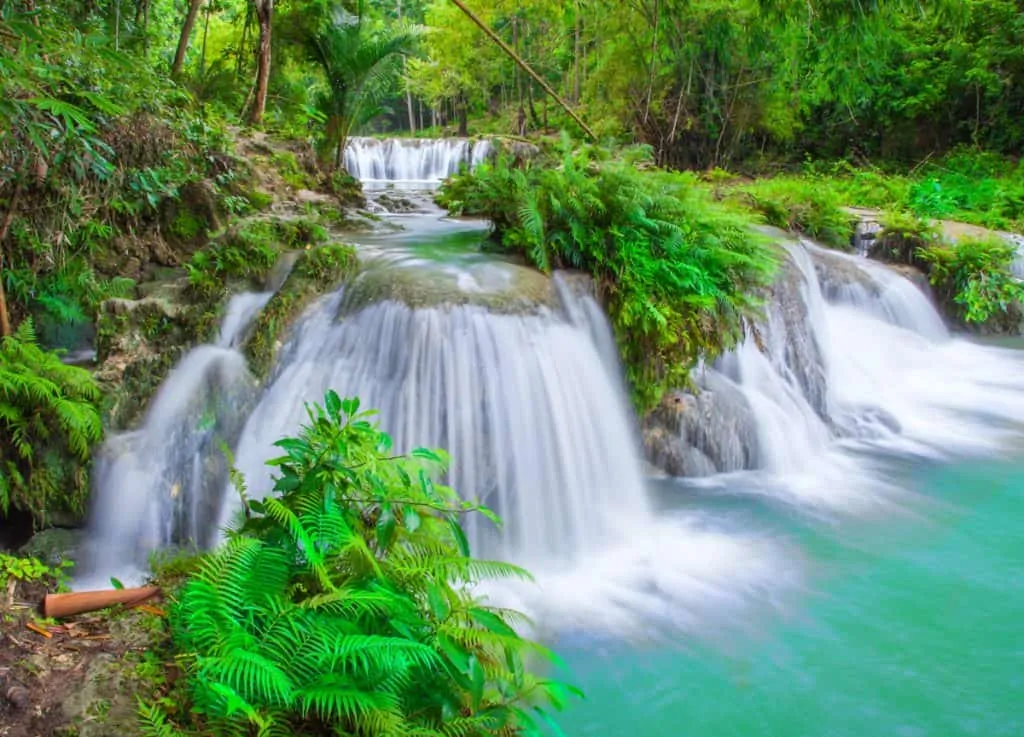


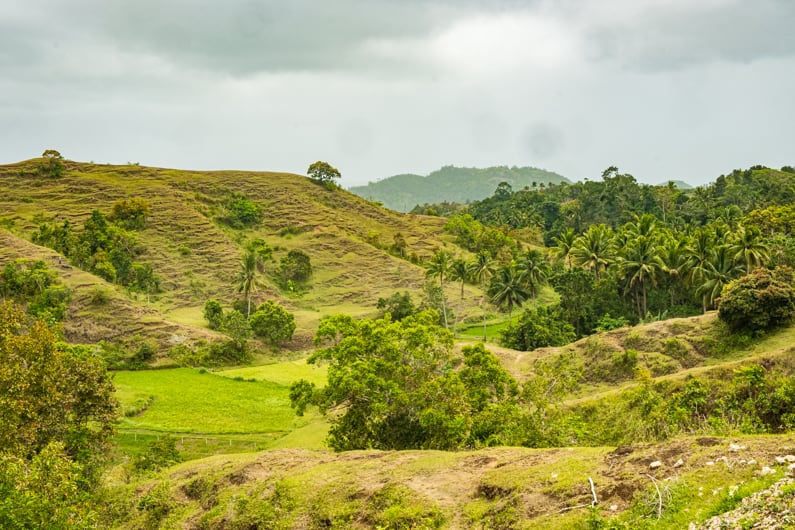






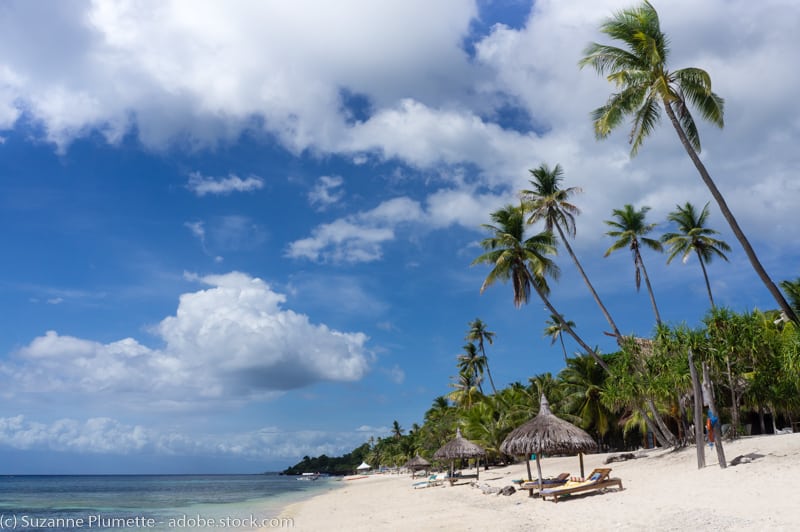



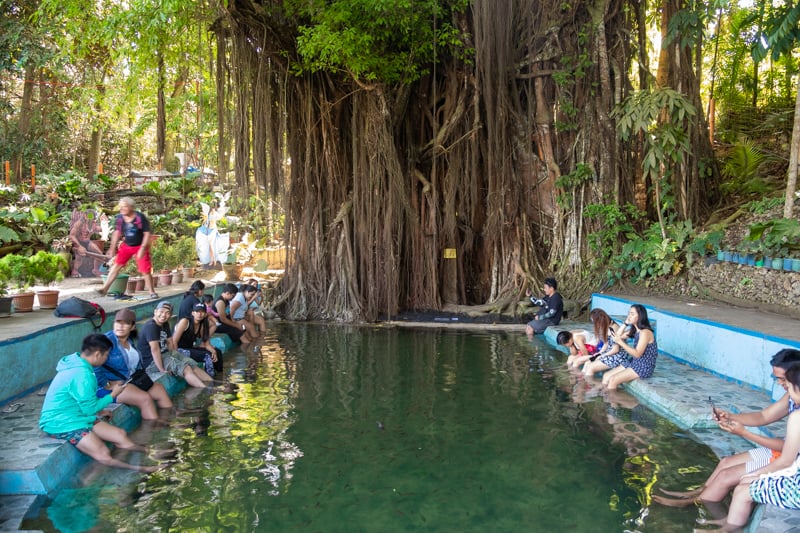






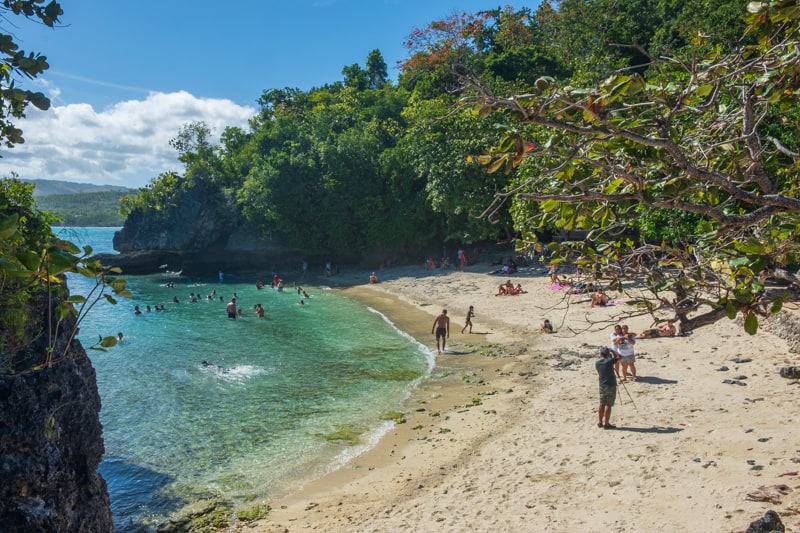

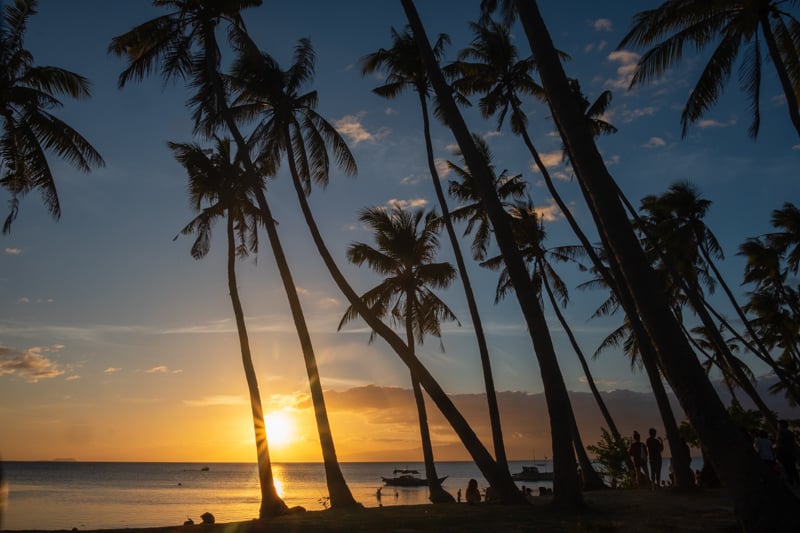

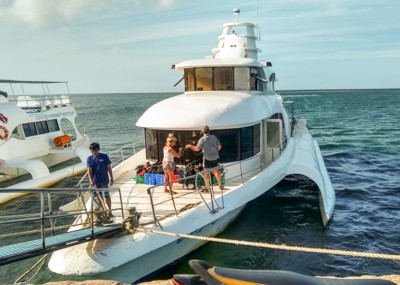


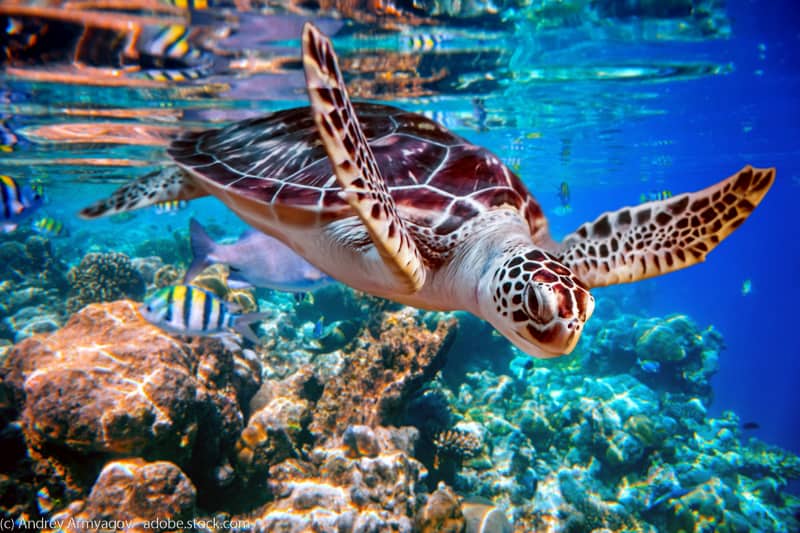


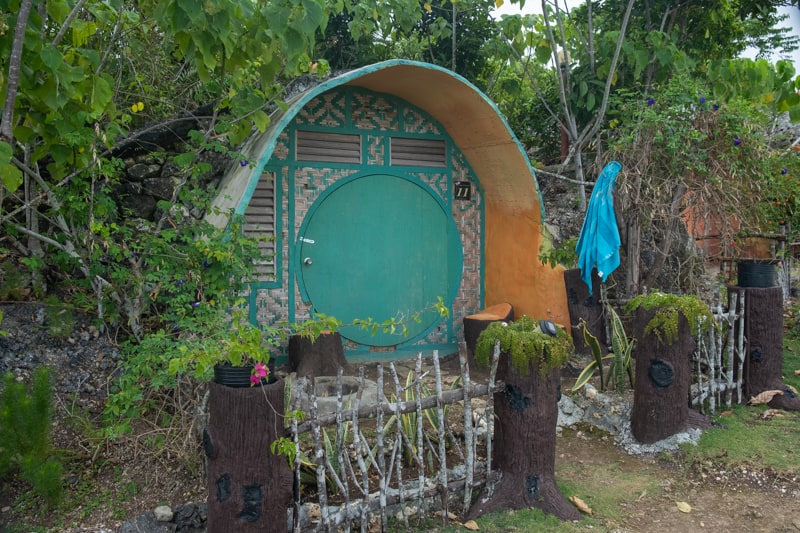






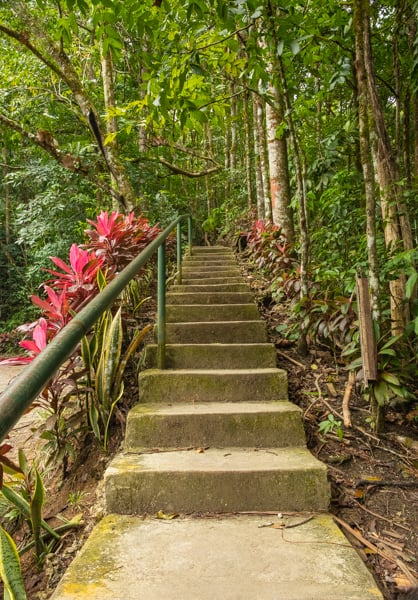

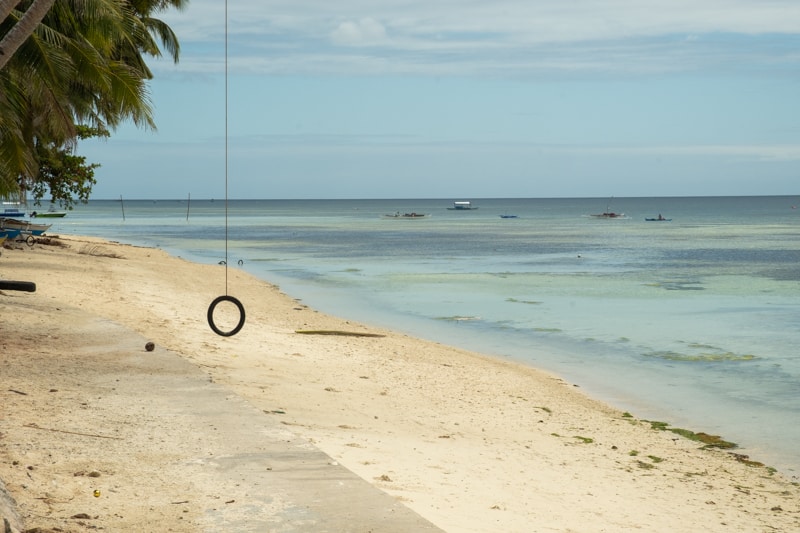









This is a pretty budget friendly trip! You did an amazing job breaking down all possible details to be considered for planning!- Pinned for our future philippines trip!
Thanks! I hope you make it to Siquijor!
I am so happy I found this guide! It’s so detailed and covered everything I could want to know. Im hoping to visit next year and island hop for a couple of weeks!
Thank you! I’m glad that you found it helpful.
Wow Siquijor sounds like a really special place which I would love to visit.did u find fireflies ? Thanks for sharing this itinerary
It’s a great place to visit. Nope! No fireflies!
Looks magical! Will definitely hire a driver when I go, thanks for the tip! Beautiful post!
Siquijor seems like a peace of heaven on earth. When I read that it’s name may come from fireflies I thought it was a small and magical location but the reality is that it is much larger than I thought with plenty of activities. And the beaches are so beautiful! And good to you for cliff jumping, even once, I don’t think I would have done it!
I never actually went cliff jumping. Too chicken. My guide did, though. Twice.
Can’t wait to go back to the Philippines! So many islands to explore and they all have such beauty. You’ve added Siquijor to my list!
Wow! This looks so beautiful! Thanks for the super useful information about transport. I am looking into a solo trip to Asia later this year or 2021, and I appreciate your insight into Siquijor as a solo female friendly destination.
Great info! I want to stay in a Hobbit Hut!
You had me at waterfalls and the marine sanctuary! Wow this seems like such a gorgeous place.
It is totally gorgeous!
Thanks for sharing this, Julie. There are so many islands in the Philippines that it’s difficult to pin down which ones to visit. This comprehensive guide to Siquijor tells me all I need to know.
You’re welcome! I hope you get a chance to visit some day!
This place looks heavenly. I chase waterfalls everywhere we go, your long exposure capture of the falls is SO GOOD. How does the full face snorkle mask work? Does it fog up easily/get filled with water?